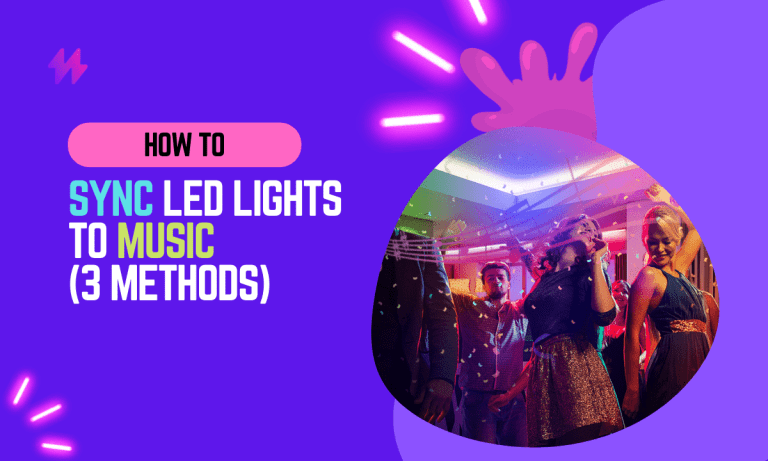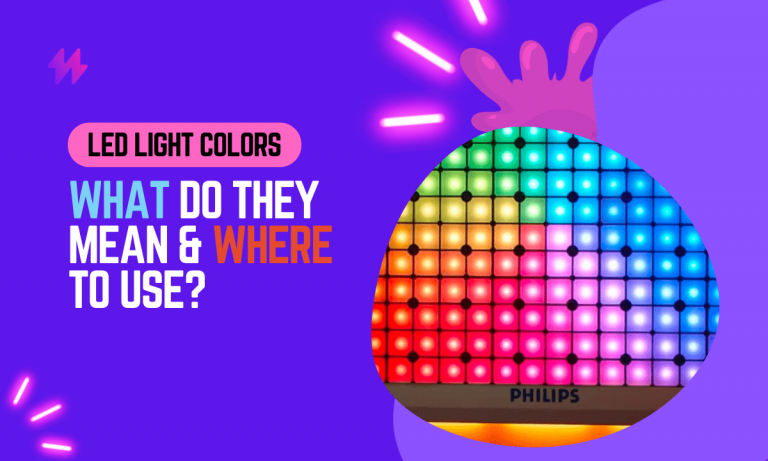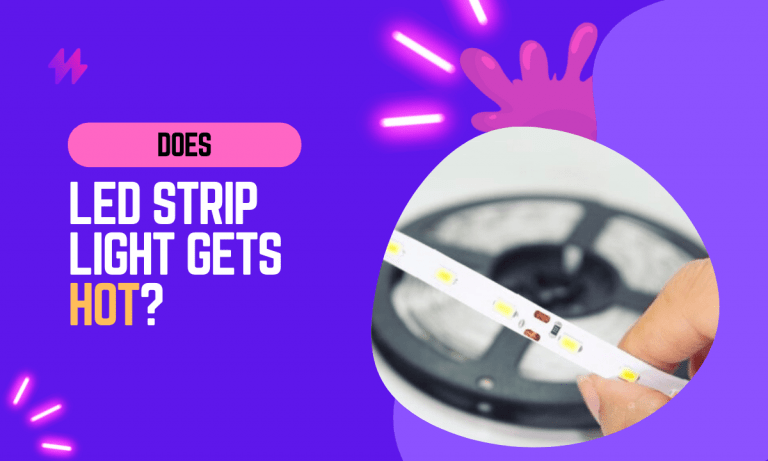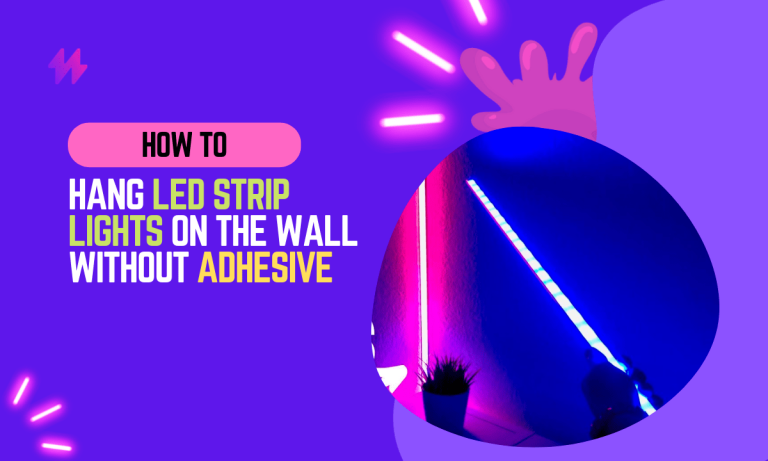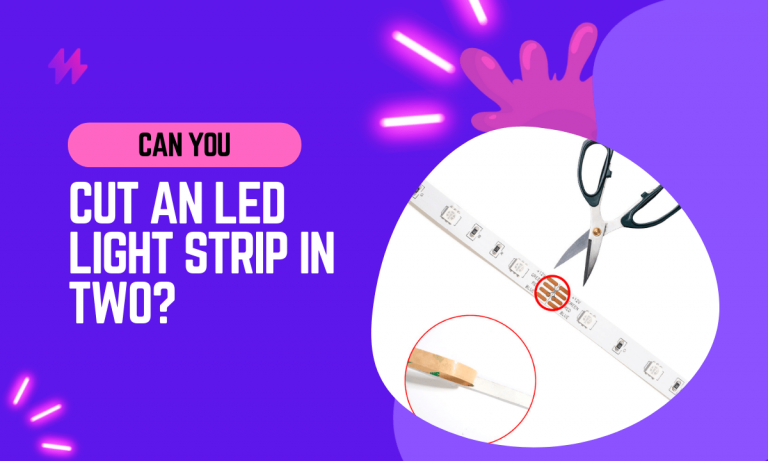Do LED Lights Attract Spiders? 3 Ways to Keep Them Away
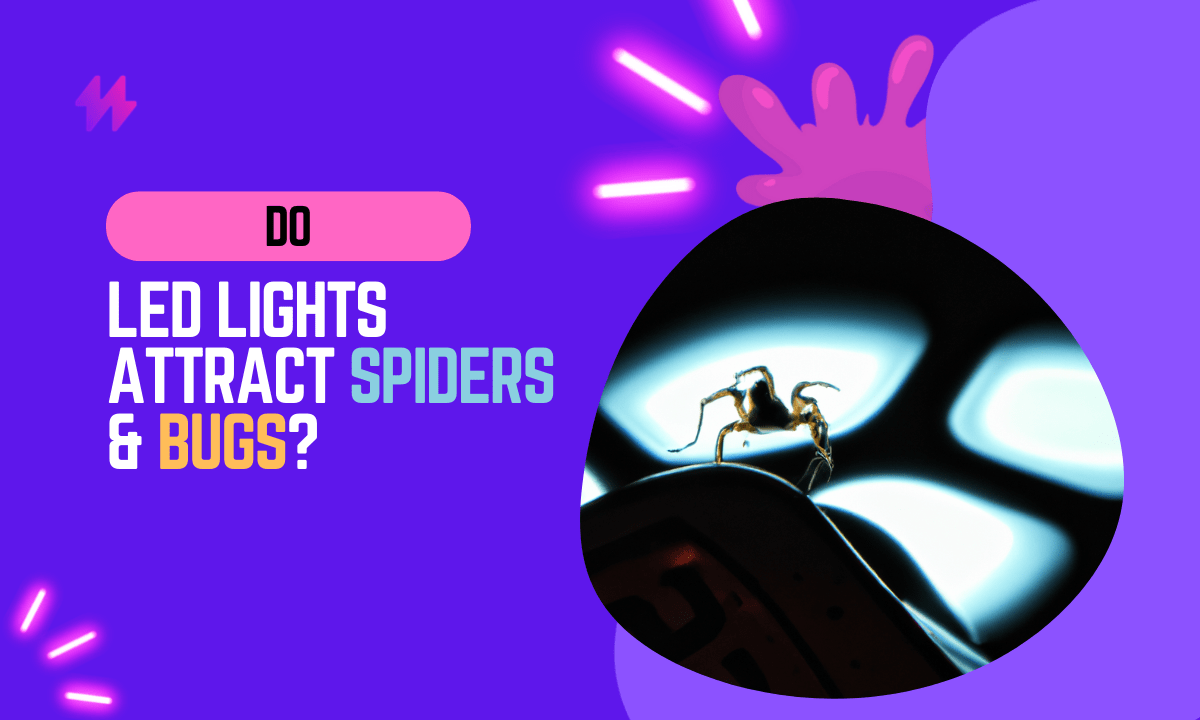
LED lights are becoming a popular choice for many homeowners due to their energy efficiency and long lifespan. But with this new technology comes a new question – Do LED lights attract spiders?
Yes, LED strip lights do attract spiders, While spiders aren’t the only creatures that are naturally attracted to LED lights, they are indirectly responsible. Many bugs prefer brighter environments and will, therefore, gravitate toward LEDs. Spiders follow their food source (which is usually insects), so it’s only logical that they would want to build a home where they can find an abundance of prey.
There are some things you can do to keep spiders away from your LED lights. In this article, we will explore the possible connection between LED lights and spider populations, and provide some tips on how to keep your LED lighting installation spider-free.
While LED lights are generally more energy-efficient compared to traditional incandescent or fluorescent lights, their appeal lies in their ability to emit light in a spectrum that can attract numerous insect species. It’s important to use insect repellents or specific lighting techniques to minimize spider activity, as homeowners can inadvertently encourage unwanted insect populations, leading to noticeable spider presence around their LED-lit areas.
Understanding LED-Spider Interaction: Do LED Lights Attract Spiders?
LED lights emit a brighter light than traditional incandescent bulbs, making them an attractive option for many homeowners. LED strip lights can also run cooler than other lighting options, which is why they are often used to illuminate outdoor spaces such as gardens and walkways. But these same characteristics can also make LED strip lights an ideal habitat for spiders.
Spiders need three things in order to survive: warmth, shelter, and food sources (insects). LED strip lights provide the perfect combination of these elements and are thus irresistible homes for arachnids. Additionally, LED strip lights do not emit UV radiation like some traditional lightbulbs; this means that insects will be more attracted to LED lighting because it does not repel them away.
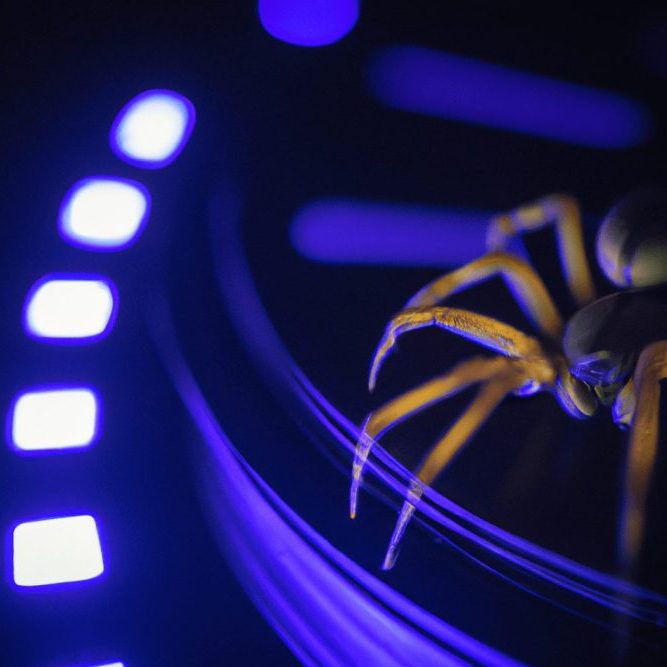
For the most part, spiders are mostly seeking out blue light wavelengths. The average human eye sees within a range of 300-420 nanometers, which also just so happens to be where ultraviolet light falls on the spectrum of colors. Read our detailed guide here about why LED light attracts insects.
LED lights, despite being energy-efficient, can inadvertently create a welcoming environment for various insect species due to their luminescent qualities. As a result, homeowners dealing with significant spider activity may consider implementing natural spider repellents and relocating their led lighted fixtures to minimize insect traffic around their homes.
Understanding What Color LED Lights Attract Spiders The Most
Studies have found that LED lights emit a blue light wavelength and this is what attracts spiders the most. LED strip lights, in particular, are very attractive to spiders because they are so energy efficient and run cooler than other types of lighting options. LED strip lights also do not emit UV radiation like traditional incandescent bulbs, which means insects will be more attracted to LED lighting because it does not repel them away.
Many insects are attracted to light sources because they use them to help navigate at night. However, these same bugs are generally not as interested in warm colors that simulate the midday sun. You may see fewer insects and spiders if you use warm yellows, reds, and whites. Bugs are attracted to bright lights in general and to the warmth of a light bulb.
You won’t be able to completely avoid bugs by using yellow light in your home, but it will help.
Yellow LED lights may not completely repel spiders, but they can make your LED lighting installation less attractive to them.
LED lights, while energy-efficient and cool to the touch, can create an environment that attracts various insects, including unwanted species such as jumping spiders and wolf spiders. By choosing yellowish lights over brighter, more traditional light bulbs, homeowners can help reduce the likelihood of spider webs appearing and mitigate the overall spider problem around their properties.
Strategies to Prevent LED Lights from Attracting Spiders
1. Make sure LED lights are pointed away from the ground. LED strip lights should be installed in such a way that they’re not pointing straight at the ground, as this will attract more insects and spiders to your LED lights.
2. Try using LED dimmers or using lower-wattage LED bulbs. LED dimmers are an effective way of controlling how bright your LED lights can get, which can help reduce their attractiveness to spiders and other insects. Additionally, using lower-wattage LED bulbs may also help reduce the amount of light emitted and make them less attractive to pests.
3. Try yellow-tinted LED lights or motion-activated LED lights. 4000K LED light bulbs emit a warmer color than regular LED lights, which can help repel insects and spiders. Additionally, motion-activated LED lights will only light up when movement is detected nearby, which can also help reduce their attractiveness to pests.
To reduce spider activity around your home, consider positioning your light fixtures in a way that minimizes light directed at the ground, which often attracts undesired insects like moths. Replacing high-powered light bulbs with dimmable LEDs can also effectively deter numerous spiders while allowing you to maintain efficient lighting in your outdoor spaces.
Conclusion on Spiders and LED Lights
In conclusion, the relationship between LED lights and spider attraction is not directly about the spiders being drawn to the light itself, but rather to the insects that are attracted to these lights. LED lights, particularly those emitting blue or ultraviolet light, tend to attract flying insects, which in turn can lure spiders seeking prey. This indirect consequence makes it important for homeowners and facility managers to consider the spectrum of light emitted by their LED installations if they wish to minimize both insect and spider populations in and around their properties. Implementing LEDs with warmer, yellow-toned lights, which are less attractive to most insects, can be an effective strategy in reducing the likelihood of attracting spiders that prey on these insects.
Additionally, beyond the choice of lighting, there are practical steps that can be taken to further discourage spiders from taking up residence in areas illuminated by LEDs. Keeping outdoor lighting fixtures clean and free from insects, using physical barriers such as screens and seals on windows and doors, and regular maintenance of garden and yard areas to remove webs and disrupt spider habitats can all contribute to a reduction in spider populations. Moreover, strategic placement of lights away from direct entry points to the home, such as windows and doors, and using motion-activated lights can limit the continuous illumination that draws insects and, consequently, spiders. These integrated pest management approaches, when combined with selective lighting choices, offer a comprehensive strategy for homeowners looking to enjoy the benefits of LED lighting without the downside of increased arachnid visitors.
If you’re still having trouble, try changing the color of your LED light . Insects aren’t attracted to warmer colors like red, orange, and yellow as much as they are to cooler colors.
The effective management of spider populations often involves understanding and modifying the conditions that lead to insect attraction. By selecting warmer light wavelengths or repositioning outdoor lights away from potential spider habitats, homeowners can create environments less favorable for unwanted insect activity and thereby minimize spider behavior.
Exploring Similar Posts: Insights on LED Lights and Spider Attraction
Choosing the right E12 light bulb may seem like a simple task, but it can significantly impact the ambiance, energy efficiency, and overall functionality of your lighting fixtures. With a…
Glare is an unfortunate problem that comes with LED lights. While they are more efficient and longer lasting than other light bulbs, they can be quite harsh on the eyes….
Light bulbs are an essential part of our daily lives, providing us with the ability to see in the dark and illuminating our homes and workplaces. When it comes to…
Lighting is an essential part of any interior design, and it can have a significant impact on the look and feel of a space. When it comes to choosing the…
LED strip lights are a popular way to light up a room. They can be used in a variety of ways, from creating ambiance to providing task lighting. And while…
Have you ever wondered how to use LED lights to create different moods in your home? LED lights are a great way to add ambiance and personality to any space,…
Selecting the appropriate light emitting diodes (LED lights) can drastically influence the way a space feels while also being energy efficient. Implementing insect screens and natural bug repellents can further enhance your home lighting strategy, minimizing the influence of artificial lighting on local insect populations and discouraging unwanted infestations.
Do LED Lights Attract Spiders | Investigating the Science Behind LED Lights and Spider Behavior
The question of whether LED lights attract spiders delves into the complex interactions between artificial light sources and spider behavior. LED (light emitting diode) lights are designed to be energy-efficient, producing illumination with varying wavelengths that may affect nocturnal insects differently than traditional incandescent lights or fluorescent bulbs. Many LEDs emit white light, which can still draw countless unwitting insects, particularly those that are attracted to the insect-attracting spectrum. Although lighter colors may capture more attention, LED lights are unlikely to attract spiders directly. Instead, these lights often serve as a luminescent lure for pollinating insects, inadvertently drawing these small insects closer to potential spider habitats. The behavior of various spiders, such as crab spiders, can be influenced by the presence of lights, especially when they are placed closer to natural habitats like gardens or shrubs, where food guides spiders towards their next meal. As night falls, brighter light sources from street lamps or porch lights can increase insect activity, making outdoor areas a hotspot for spider encounters. Understanding light perception and the wavelength of light helps clarify the indirect relationship between LED illumination and spider attraction.
Do LED Lights Attract Spiders | The Role of Light Spectrum in Spider Attraction
Artificial lights, including LED lights, can significantly influence insect behavior and, consequently, spider attraction. The light spectrum emitted by different lights plays a crucial role in this interaction. Brighter lights and white lights often attract a multitude of insects, drawn in by wavelengths that mimic natural light sources. Insects’ keen eyesight can detect ultraviolet (UV) light, making it a strong attractant for countless insects. This draw towards artificial lights, particularly those placed closer to natural habitats like gardens or water sources, can inadvertently enhance spider populations as they come to feed on these unwanted insects.
The relationship between light wavelength and spider attraction is complex. Energy-efficient LEDs emit varying wavelengths that can either attract or repel insects compared to traditional bulbs. The preference of certain insects for specific light wavelengths feeds into the spider’s feeding patterns. Traps set up near multiple light sources can capture various insects, revealing the specific light conditions most conducive to attracting them. Each type of light, whether an LED light source or traditional lights, affects nighttime activity and influences insect behavior, ultimately leading to questions about whether LED lights attract spiders.
How Brightness Affects Spider Activity
Brightness plays a crucial role in spider activity, influencing their behavior and attraction to various light sources. Do LED Lights Attract Spiders? The answer depends significantly on how bright the lights are and their wavelengths. Street lights often draw insects due to their brightness, which in turn attracts spiders that prey on these insects. Lights placed closer to natural habitats, like gardens, shrubs, or water sources, can create an environment where spider populations thrive. However, LED technology can mitigate attraction when not excessively bright, as intense lights can be a beacon for insects, drawing them closer.
Various lights, including indoor lights, can affect the insect world. The intensity of light impacts how insects perceive their surroundings, leading them toward brighter sources. UV light is particularly effective at attracting bugs, making it essential to consider the types of light used in and around the home. Maintaining proper brightness levels and relocating lights away from areas where insects gather can serve as a natural bug repellent. Cleaning LED lights regularly to remove accumulated dirt helps reduce unwanted insect attraction, thereby minimizing spider presence.
RealWorld Observations of Spiders Near LED Lights
Environmental studies have highlighted intriguing interactions between LED lights and spider populations. The wavelengths of LED lights play a critical role in this relationship, as specific light colors can attract various insects that serve as spider prey. This light attraction draws insects towards illuminated areas, subsequently inviting spiders that seek food. Observations have noted that dirt accumulating on LED lights can obscure this light matter, potentially affecting its visibility and subsequent insect attraction. Areas where lights are poorly maintained may see a fluctuation in insect populations, thereby influencing spider activity. Homeowners often experiment with relocating lights to optimize the balance between illumination and insect attraction. In addition, the use of natural bug repellents and insect repellent products has been considered to minimize the presence of insects, aiming to reduce the spider population around these lights. Understanding these dynamics can assist in answering the question, do LED lights attract spiders?
Case Studies: Areas with High LED Usage and Spider Population
Research has shown that areas with high LED usage often experience increased spider populations. One of the reasons insects are attracted to these environments is the specific lights’ wavelength, which can draw in various bugs. As insects gather due to the appealing light, spiders follow suit, hoping to capitalize on the abundant food source. The reflective surfaces, such as mirrors and bright walls, can further enhance this effect, making it easier for lights to attract insects, which in turn attracts spiders.
Observations in urban settings indicate that LED lights can influence spider activity significantly. Homeowners using such lighting should consider relocating lights to shine downwards, minimizing their reach and reducing insect attraction. By implementing natural bug repellents and maintaining clean areas free of led lights dirt, the overall presence of insects decreases, indirectly lowering the spider population. Understanding whether LED lights attract spiders can help residents make informed decisions about their outdoor lighting strategies.
Seasonal Variations in Spider Attraction to LED Lights
Seasonal changes can significantly affect spider attraction to various light sources. During warmer months, the presence of natural bugs increases, which in turn leads to heightened spider activity. This heightened spider presence raises the question, do LED lights attract spiders? The wavelength of LED lights plays a crucial role in their attraction. Spiders are generally drawn to specific light wavelengths, potentially prompting homeowners to consider relocating lights or directing them downwards to minimize the likelihood of attracting these arachnids.
During colder months, spider activity typically decreases as natural food sources become scarce. However, improperly placed LED lights can still attract wandering spiders, curious about the light’s allure despite a drop in their overall population. Effective use of natural bug repellents can further reduce the chances of attracting spiders to areas where LED lights are installed. Understanding how these factors interact can help answer the question, do LED lights attract spiders, providing strategies to manage outdoor and indoor lighting effectively.
Comparative Analysis of LED Lights and Traditional Lighting
The question of whether LED lights attract spiders has garnered attention among homeowners seeking effective lighting solutions. LED lights emit specific wavelengths that can either attract or deter spiders, depending on the spectrum used. Generally, warmer lights with lower wavelengths may not be as appealing compared to cooler, high-wavelength options. To minimize spider attraction, homeowners can strategically relocate lights and direct them downwards, reducing exposure in areas where spiders are likely to thrive. Incorporating natural bug repellents in outdoor spaces can further discourage spider presence, leading to a more pleasant environment. Understanding the relationship between light types and spider behavior can help determine if LED lights attract spiders, assisting in the choice of the best lighting practices.
LED vs. Incandescent: Which is More Attractive to Spiders?
Research indicates that LED lights can be less attractive to spiders compared to traditional incandescent bulbs. The difference primarily lies in the lights’ wavelength. LED lights often emit a spectrum that is less appealing to many insects, which in turn serves as a natural bug repellent. These insects are typically drawn to warmer, more yellow wavelengths found in incandescent lighting, making regions illuminated by these bulbs more likely to experience increased spider attraction.
The positioning of the lights also plays a crucial role in spider activity. LEDs tend to be designed to focus light downwards, minimizing the area of illumination. This contrasts with incandescent bulbs that may disperse light more widely, creating a larger area that can attract various bugs. A smaller attraction area potentially leads to fewer spiders, contributing to questions around do LED lights attract spiders and their effectiveness in managing spider populations.
The Impact of Different Light Sources on Spider Behavior
Different light sources produce varying wavelengths, which can influence spider behavior and attraction levels. Studies reveal that spiders are often drawn to certain wavelengths emitted by light sources, especially those that mimic natural light. LED lights may attract spiders more than other types due to their spectral range and intensity. The question of “Do LED lights attract spiders?” has prompted researchers to investigate how the specific wavelengths affect spider activity and their interaction with nearby ecosystems.
Natural bug repellents play a crucial role in mitigating spider attraction to artificial light sources. The presence of certain environmental factors, like the abundance of natural predators or the availability of food sources, can determine how spiders respond to different lights. By understanding these dynamics, homeowners can better address the question of “Do LED lights attract spiders” and make informed decisions on lighting choices to minimize unwanted spider presence in their surroundings.
Practical Tips for Homeowners to Minimize Spider Attraction
Homeowners can take several steps to minimize the attraction of spiders to their properties, particularly regarding outdoor lighting. Understanding whether LED lights attract spiders involves considering the lights’ wavelength; certain colors may be more appealing to these creatures. Opting for warmer LEDs or yellow-toned lights can significantly reduce spider attraction since these wavelengths tend to attract fewer insects, which are primary food sources for spiders. Utilizing natural bug repellents around the yard can also help deter both insects and spiders. Addressing these factors not only contributes to a more pleasant outdoor environment but also mitigates the questions about do LED lights attract spiders.
Choosing the Right Type of Lighting for Your Home
The type of lighting you choose for your home can influence spider attraction. Certain wavelengths of light emitted by LED bulbs may be more appealing to spiders and other insects. Research suggests that warmer light tones, which typically fall within the yellow and red spectrum, are less likely to attract bugs. Homeowners should consider the lights’ wavelength as a key factor in reducing unwanted spider presence. Understanding whether LED lights attract spiders can guide your selection, enabling you to create a less inviting environment for these creatures.
Natural bug repellents can complement your lighting choices. For instance, incorporating plants like lavender or mint around outdoor lighting can deter insects while keeping your space visually appealing. Selecting LED lights that emit less blue light may also decrease the likelihood of spider attraction. By strategically considering both the type of lighting and surrounding natural remedies, you can create a harmonious living space while minimizing spider encounters.
Effective Maintenance Strategies to Reduce Spider Presence
Regular maintenance of outdoor areas can significantly minimize spider presence. Keeping your garden and surroundings tidy reduces potential habitats for spiders. Using natural bug repellents can also be effective. These repellents not only help to deter spiders but also limit the number of insects that may attract them. Homeowners often wonder, do LED lights attract spiders, and understanding the relationship between lights wavelength and insect behavior may assist in making informed decisions.
Maintaining lights and fixtures is equally important. Dirty lights can inadvertently become attractive to spiders as they may attract more insects. When evaluating your lighting, consider switching to LED lights with wavelengths that are less appealing to bugs, as this can help decrease spider attraction. Learning how various light types influence spider behavior can guide homeowners in creating a less inviting environment for these eight-legged creatures.


